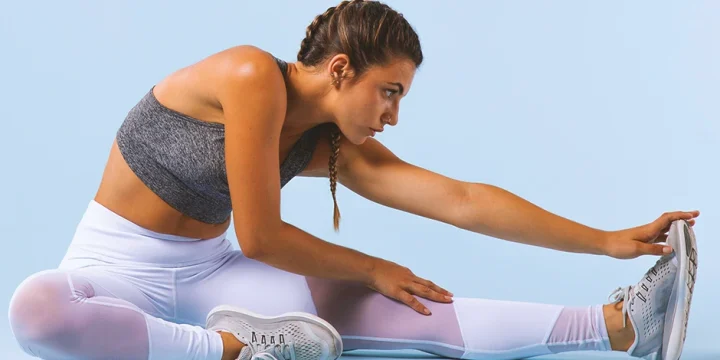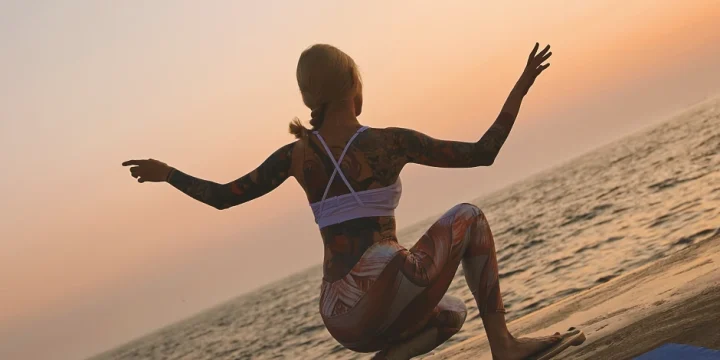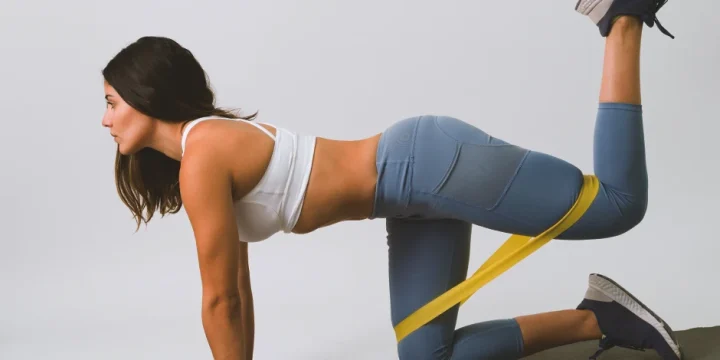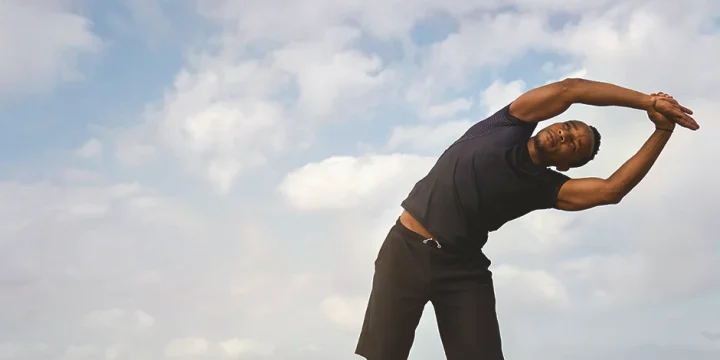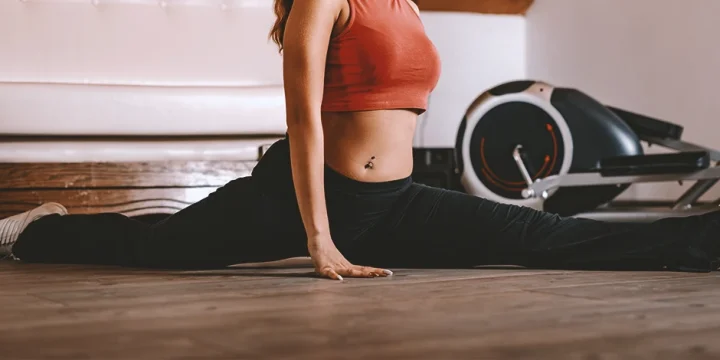Stretching exercises are essential to any fitness routine, and targeting the latissimus dorsi muscles (or lats) is no exception.
Stretching has been part of every fitness plan I have created for clients over the last decade. By incorporating these stretches into their routine, they tone their backs and improve their posture and everyday mobility.
This article will outline the seven best lat stretches my clients have used successfully. From the starting position to releasing the stretch and using a foam roller, you’ll have all you need to relieve tight lats.
Let’s begin.
Quick Summary
- As the largest upper-body muscle, the latissimus dorsi contributes to many movements, including shoulder extension and lateral flexion.
- Lat stretches can improve overhead shoulder mobility, upper body tension, back pain, and the ability to do upper body workouts.
- A study from PubMed showed that implementing dynamic stretches into your pre-workout routine positively affects your range of motion and performance.
- Different sports place unique demands on the latissimus dorsi muscles, so I recommend customizing lat stretches for specific sports to enhance your performance and reduce the risk of injury.
Best Stretches for the Lats

Over the years, I've found that the following lat stretches will help you avoid pain in your back and shoulder, improve shoulder mobility, and reduce muscle tension.
Before we go on, remember that you should never force yourself to stretch or push beyond your limits.
Always use proper form, and stop stretching if you feel pain or discomfort.
Now, let’s dive into the best ones.
1. Hanging Lat Stretch
You need a sturdy overhead beam or pull-up bar to do this stretch and relieve tension in the lats.
To do this stretch:
- Reach up and grab the bar with an overhand grip just wider than shoulder distance apart.
- Lift your feet off the ground.
- With your arms fully extended, allow your body to hang freely.
- Slowly and gently sway back and forth, allowing your body to stretch and relax.
- Hold the stretch for a minimum of 15–30 seconds.
Variation: One-Arm Hanging Lat Stretch
Similar to the two-arm hanging lat stretch but allows you to target one side at a time. Simply follow the steps above, but hang from one arm at a time.
2. Unilateral Fixed Bar Lat Stretch
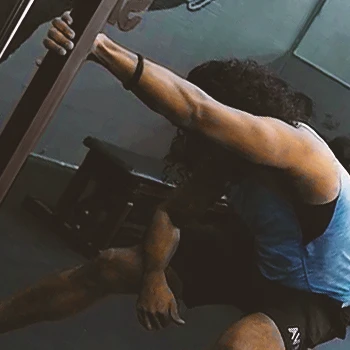
This standing lat stretch uses a fixed bar or surface to stretch one lat muscle at a time.
To do this stretch:
- Stand next to a fixed bar or surface that is waist-high.
- Grip the bar with one hand slightly wider than the shoulder distance apart.
- Step back with the foot opposite the hand you hold the bar with, creating a slight diagonal angle in your body.
- Keep your arm straight and your shoulder blades pulled down and back.
- Slowly and gently lean your body away from the bar, allowing your lat muscle to stretch.
- Hold the stretch for a minimum of 15–30 seconds.
- Slowly release the tension in your lat muscle and return to the starting position.
- Switch sides and repeat the stretch with the other arm.
3. Bent Arm Wall Stretch
You’ll use a wall for one of the best lat stretches before a workout that is effective for your chest and shoulders.
To do this stretch:
- Stand facing a wall with your feet hip-distance apart.
- Place your palms on the wall with your fingers pointing up and at shoulder height.
- Step forward with one foot.
- Bend your elbows and lower your chest.
- Keep your shoulders down and your back straight.
- Hold the stretch for a minimum of 15–30 seconds.
4. Bench Kneeling Lat Stretch
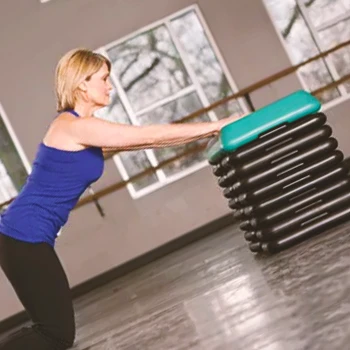
If you want to improve overall flexibility, this is one of the best lat stretches to lengthen and stretch the muscle.
To do this stretch:
- Place a bench or sturdy surface (like a bench) in front of you.
- Kneel with your knees hip-width apart, facing the bench.
- Place your hands on the bench, shoulder-distance apart, with your fingers facing forward.
- Slowly walk your hands forward, lowering your chest toward the ground.
- Keep your arms straight and your shoulders down and back.
- Lower your chest toward the ground, feeling a stretch in your lats and shoulders.
- Hold the stretch for 15–30 seconds or longer if it feels comfortable.
- Rest for a few seconds and repeat the stretch.
5. Bent Over Lat Stretch
Like many other lat stretches, this exercise also works your upper back and shoulders.
To do this stretch:
- Stand with your feet shoulder-distance apart and bend forward at the hips.
- Keep your back straight.
- Let your arms hang toward the floor with your palms facing inward.
- Reach your arms behind you, keeping them straight.
- Interlace your fingers behind your back. You can hold a towel or resistance band to bridge the gap if you can’t reach your hands.
- Pull your arms away from your body and lift them toward the ceiling.
- Keep your shoulders down and your back straight.
- Hold the stretch for 30 seconds or longer if comfortable.
6. Standing Lateral Stretch
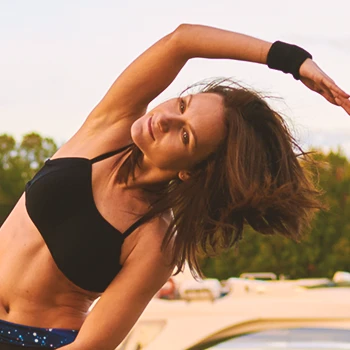
The static standing stretch also works the obliques, intercostal muscles, hip abductors, and glute medius.
To do this stretch:
- Stand with your knees slightly bent and your feet shoulder-distance apart.
- Place one hand on your hip and the other behind your head.
- At this point, your elbow will be lateral to your head.
- Keep your hand on your head and slowly raise your arm until your elbow points upward.
- You should feel the stretch down the side of your torso.
- Hold the stretch for 30 seconds or longer if it’s comfortable.
- Slowly return to the starting position to release the stretch.
- Repeat on the opposite side.
7. Lying Whole Body Lat Stretch
This stretch is an excellent way to relieve upper-body stress when your lats feel tight.
To do this stretch:
- Lie down on your back on a yoga mat or padded surface.
- Raise your arms toward the ceiling.
- Keep your arms straight and your palms facing each other.
- Slowly lower your arms down toward the floor, keeping them straight.
- When you feel a stretch in your lats and upper back, hold for 30 seconds or longer if the stretching still feels comfortable.
- Release the stretch by slowly bringing your arms back up toward the ceiling.
- Repeat 2-3 times.
“Dynamic stretching is typically done before you start your workout, and involves active movements (...) static stretching, on the other hand, is done at the end of your workout, and involves stretches that you hold in place for a period of time, without movement.”
- Emily Cronkleton, Certified Yoga Instructor
Dynamic Back & Shoulder Stretches

You can do several dynamic latissimus dorsi stretches to warm the muscles before exercise.
A study from PubMed showed that implementing dynamic stretches into your pre-workout routine positively affects your range of motion and performance [1].
Let’s get into the stretches, but remember to stretch slowly in a controlled motion.
1. Arm Circles
Arm circles are a dynamic shoulder stretch that warms up the arm, shoulder, and back muscles.
To do this stretch:
- Stand with your feet shoulder-width apart.
- Extend your arms out to your sides at shoulder height.
- Make small circles with your arms, gradually increasing the size of the circles.
- Repeat for 10–15 circles, and then go in the opposite direction for 10–15 rotations.
2. Shoulder Rolls

Not only will this exercise increase shoulder mobility and release tight lats, but the entire musculature of the upper back and neck will also loosen.
To do this stretch:
- Stand with your feet shoulder-width apart.
- Allow your arms to hang at your sides.
- Roll your shoulders forward, up, back, and down in a circular motion.
- Repeat for 10-15 rolls in each direction.
3. Cat-cow Stretch
This deep stretch increases the flexibility of your neck, shoulders, and spine.
To do this stretch:
- Begin on your hands and knees. Align your wrists with your shoulders and your knees with your hips.
- Inhale as you arch your back and lift your head and tailbone toward the ceiling to make the cow pose.
- Then exhale and round your spine, tucking your chin toward your chest and bringing your tailbone toward your knees, making the cat pose.
- Repeat for 5–10 rounds.
Also Read: How To Perform The Cat Stretch Exercise
4. Foam Rolling the Lats
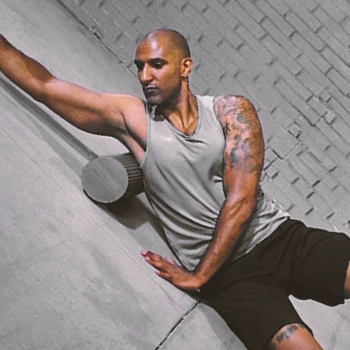
Foam rolling is an effective way to relieve tension in the lats. I especially do it before heavy lifts that use my lats.
These are the steps:
- Sit on the floor with both legs bent in front of you and a foam roller behind you.
- Lean back on one side, pushing against the foam roller with your upper back.
- Brace yourself with the same side arm.
- Reach across your body with the opposite arm and rest it on your shoulder.
- Slowly roll, starting at the top of your back and ending at your lower back.
- Slowly and gently roll back and forth.
Lat Stretches for Specific Sports
Different sports place unique demands on the latissimus dorsi muscles, so I recommend customizing lat stretches for specific sports to enhance your performance and reduce the risk of injury.
Here’s how you can do lat stretches for the following sports:
- Swimming: Swimmers require exceptional upper body strength and flexibility. Incorporate stretches like the standing lat stretch with rotation, which mimics the arm movement in strokes, enhancing shoulder mobility and lat flexibility.
- Rowing: Rowers can benefit from seated lat stretches that focus on extending the arms and leaning forward from the waist, similar to the rowing motion. This stretch helps in lengthening the lats and improving the reach in each stroke.
- Baseball: Baseball players, especially pitchers, need strong and flexible lats to improve shoulder mobility when pitching [2]. The kneeling lat stretch, where one arm is raised and leaned towards the opposite side, can help in mimicking the throwing motion, thereby improving flexibility and reducing the risk of rotator cuff injuries.
FAQs
What Causes Lat Tightness?
Some causes of lat tightness include sitting for extended periods, poor posture, and repetitive overhead motion. Additionally, gripping bicycle handlebars too tight, going hard at the gym, and wearing a bra that compresses the muscles can create tight lat muscles.
When Is the Best Time to Stretch Your Lats?
The best time to stretch your lats is before and after a workout. Before exercise, it gets your muscles warmed up, and stretching after exercise relaxes the muscles, eliminates lactic acid, and gradually slows down the body.
References:
- https://pubmed.ncbi.nlm.nih.gov/29063454/
- https://www.fitnesseducation.edu.au/blog/health/why-you-should-be-stretching-your-lats-more-often/
About The Author
You May Also Like
